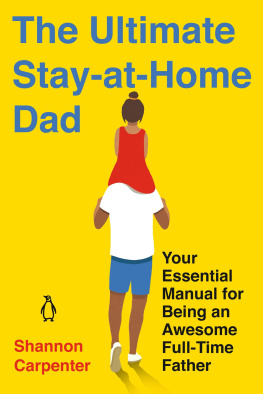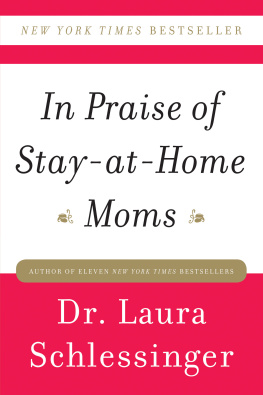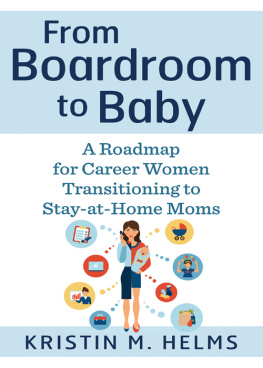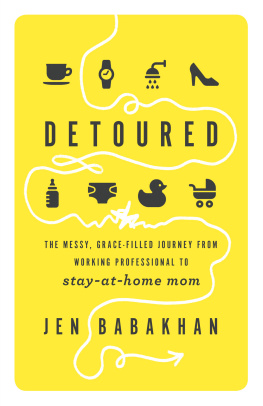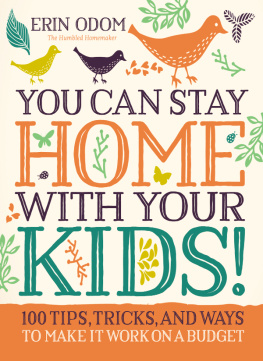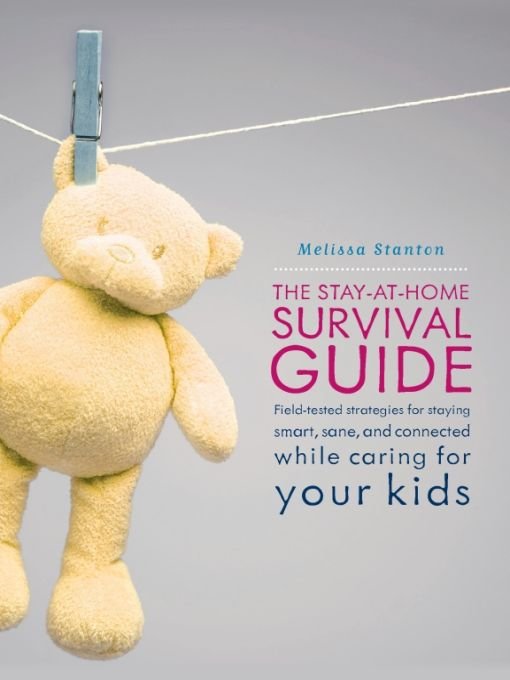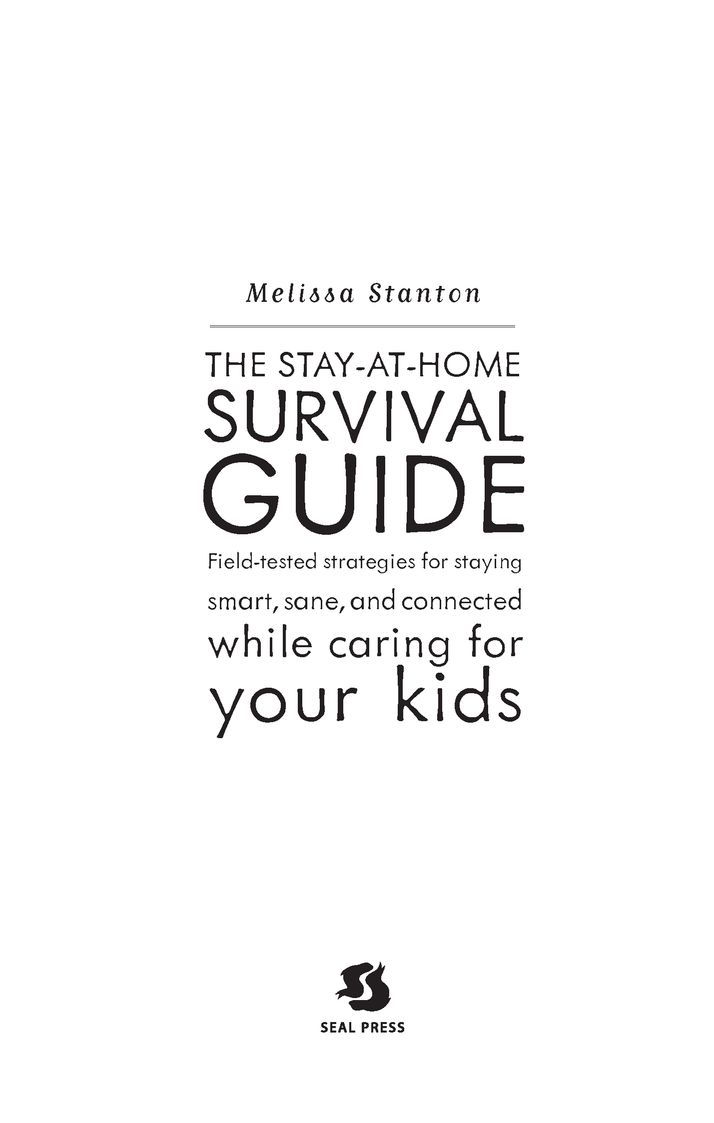Table of Contents
For my husband and children, of course.
PREFACE
Why is Stay-at-Home Motherhood Something to Survive?
Surely, for some women, being a Stay-at-Home mother is an entirely magnificent, totally blissful, always fulfilling, happilyever-after dream come true.
This book isnt for those women.
Instead, The Stay-at-Home Survival Guide is for all the other women out there who are doing the 24/7, hands-on work of raising children by being full-time Stay-at-Home momsbe they brand new mothers or veteransand who, from time to time, struggle with the challenges of this kind of in-the-trenches motherhood.
The Guide is for women like me (a Stay-at-Home mother for more than six years) and, I suspect, like you, for whom motherhood and round-the-clock parenting often have as many downs as ups. As with any job (and full-time, Stay-at-Home parenting is a job), we have moments of feeling overwhelmed, overworked, unappreciated, and under-compensated. And all thats before the 9:00 AM start of the traditional workday.
Stay-at-Home motherhood is certainly not something a woman needs to survive in the same way one survives disease or trauma or disaster or extreme hardship. Still, the constant demands that come from being the sole adult charged with the care of little minds and bodies (and the surroundings in which they exist) call for a daily routine that many Stay-at-Home moms need both skill and fortitude to survive.
The work involved in full-time parenting is often harder than many women imagined it would be. The initial relief from the pressures of paid employmentor of juggling work and familycan be quickly replaced by the demands of our new Stay-at-Home reality, identity, resulting insecurities, and lifestyle complexities. Over time, you realize that you work as many, if not more, hours than you did at a real job. And even though as a Stay-at-Home mom youre never without something to do, the day can drag, and entire weeks can feel empty of adult company or personal fulfillment. Then, in the rare instance you get to mingle among grownups without kids clinging to you, someone asks you what you do, and you struggle between saying, Im a Stay-at-Home mom ... or Well, I used to be ... or some tortured combination thereof. It can make you want to cry.
For a woman who, before motherhood, had a job she enjoyed, experienced career success, lived independently, and had an active social life, setting all that aside for Stay-at-Home motherhood can be a mixed blessing. Its wonderful for a mother to be able to devote herself to the full-time care of her familywithout the distractions, stresses, and demands of an office or workplace. Its wonderful for a child to be raised under the constant care of a parent instead of a nanny, sitter, au pair, daycare staff, or afterschool programor any of the other childcare solutions that parents need to piece together in order to earn an income. In a nation where two incomes are often essential to a familys well-being, and where single parents need a job in order to pay and keep up with the bills, Stay-at-Home mothers are often told how lucky they are not to work.
I know Im lucky that my family has been able to live securely for several years with only one income. But Im also a woman who had a significant career as a magazine editor in New York. I once held senior positions at People and LIFE magazines. I have a masters degree. I have professional skills I want to use, but theyve been put on the back burner. Putting those parts of me aside to fill sippy cups and push swings hasnt always been easy on my sense of self.
Women become Stay-at-Home moms because they choose to. They also become Stay-at-Home moms because circumstances require itsuch as when quality childcare options arent available, or too much of the households income goes toward the cost of daycare, or both parents jobs are so demanding that neither is home much for the kids. In many cases, the choice isnt much of a choice. The reasons women leave the workforce to be Stay-at-Home moms generally boil down to logistics and love.
This book wont go into the details of why the women quoted in these pages have left the workforce to be home with their children. Thats the past (and is a topic worthy of an entire book in itself). The Stay-at-Home Survival Guide is for the present and the future. Its for the galsus lucky galswhom many consider to be living the dream or, say some critics, are living in a dream world oblivious to our dependency. (More on that later.)
No matter how firm our Stay-at-Home convictions, there are timesmany, many timeswhen Stay-at-Home mothers dont feel lucky at all. Stay-at-Home motherhood is many great things, but it is also exhausting, difficult, uninspiring, isolating, mind-numbing, monotonous, depressing, frightening, self-esteem robbing, and never-ending. In that sense, for a woman to endure the demands of being a full-time Stay-at-Home mom, shed best have great strength of body, mind, and soul. In other words, shed best have strong survival skills.
Stay-at-Home mothers come in many varieties. Ive met women who are blissfully happy being the 24/7 caregivers (and, in the case of those who home-school, educators) of their children. They are living their dream. The most memorable merry mom Ive met was a very pleasant mother of three, a former tennis pro I had invited to join a neighborhood playgroup that would include her youngest and my twins, who were then two.
Ive never been in a playgroup, she responded. What is it? This was a mother of three children under age five.
Its a playdate for kids, but all the moms are there, I explained. You usually get together once a week and rotate among different houses.
That sounds nice, she said. Weve never really had kids here or played at other peoples houses.
Huh? How had this woman survived all these years? I asked her what she and her children did all day.
We play, we read books. We have a lot of books, she said.
Doesnt it make you crazy? Being home alone all day with your kids? I asked.
No, not at all, she declared earnestly. I love playing with my kids.
Ive met others like her, but just a handful. These gals are probably exceptional mothers, but they are likely far from the Stay-at-Home mom norm.
In her 1963 manifesto The Feminine Mystique, Smith College- grad turned Stay-at-Home mom Betty Friedan wrote about the problem that has no name, which was the description given by the author for the feelings of sadness and anxiety her Stay-at-Home peers could not shake. Middle-class wives and mothers of Friedans era were essentially prevented from using their education, intelligence, and professional skills in the workplace. Many employers held that marriage, and certainly motherhood, required a woman to resign her post.
While married women with children are allowed to stay in the workforce today, many cant, due to the realities involved in juggling the demands of work and the needs of a family. And while highly educated women are accused of opting out of the workforce to be mommies, many are actually forced or squeezed out for trying to be both an employee and an involved parent. Even if the precise reasons for staying home are different from those experienced by our mothers and grandmothers, the feelings that result can be the same.


